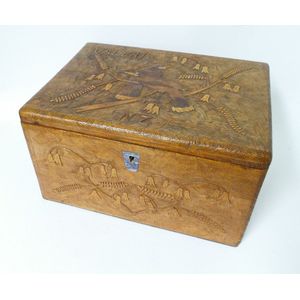Victorian Burr Walnut Jewellery Box with Mother-of-Pearl Decoration
You must be a subscriber, and be logged in to view price and dealer details.
Subscribe Now to view actual auction price for this item
When you subscribe, you have the option of setting the currency in which to display prices to $Au, $US, $NZ or Stg.
- Mother-Of-Pearl - Mother-of-pearl, technical name "nacre", is the inner layer of a sea shell. The iridescent colours and strength of this material were widely used in the nineteenth century as an inlay in jewellery, furniture, (especially papier mache furniture) and musical instruments.
In the early 1900s it was used to make pearl buttons. Mother-of-pearl is a soft material that is easily cut or engraved.
Nowadays it is a by-product of the oyster, freshwater pearl mussel and abalone industries. - Victorian Period - The Victorian period of furniture and decorative arts design covers the reign of Queen Victoria from 1837 to 1901. There was not one dominant style of furniture in the Victorian period. Designers used and modified many historical styles such as Gothic, Tudor, Elizabethan, English Rococo, Neoclassical and others, although use of some styles, such as English Rococo and Gothic tended to dominate the furniture manufacture of the period.
The Victorian period was preceded by the Regency and William IV periods, and followed by the Edwardian period, named for Edward VII (1841 ? 1910) who was King of the United Kingdom and the British Dominions and Emperor of India for the brief period from 1901 until his death in 1910. - Burr - Burr (or in the USA, burl) is the timber from the knotted roots or deformed branch of the tree, which when cut, displays the small circular knots in various gradations of colour. It is always cut into a decorative veneer, most commonly seen as burr walnut on 19th century furniture.
This item has been included into following indexes:
Visually similar items

Antique walnut jewellery box 28 cm wide

A campaign style walnut writing slope, 19th century, a brass trimmed slope with shield cartouche and matching escutcheon opening to a tooled black leather slope and fitted compartments for pens and inks, height 13 cm, width 40 cm, depth 23 cm

Early 19th century tea caddy, 23 x 12 cm

A New Zealand timber folk art jewellery box, carved in low relief to the lid and walls with huia birds and kowhai, named 'Valerie' to the lid, the interior with blue velvet lining and removable tray. 30 cm x 22 cm x 17 cm
